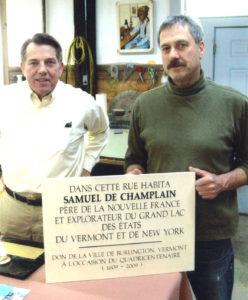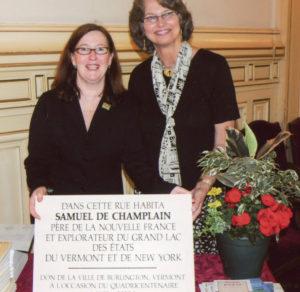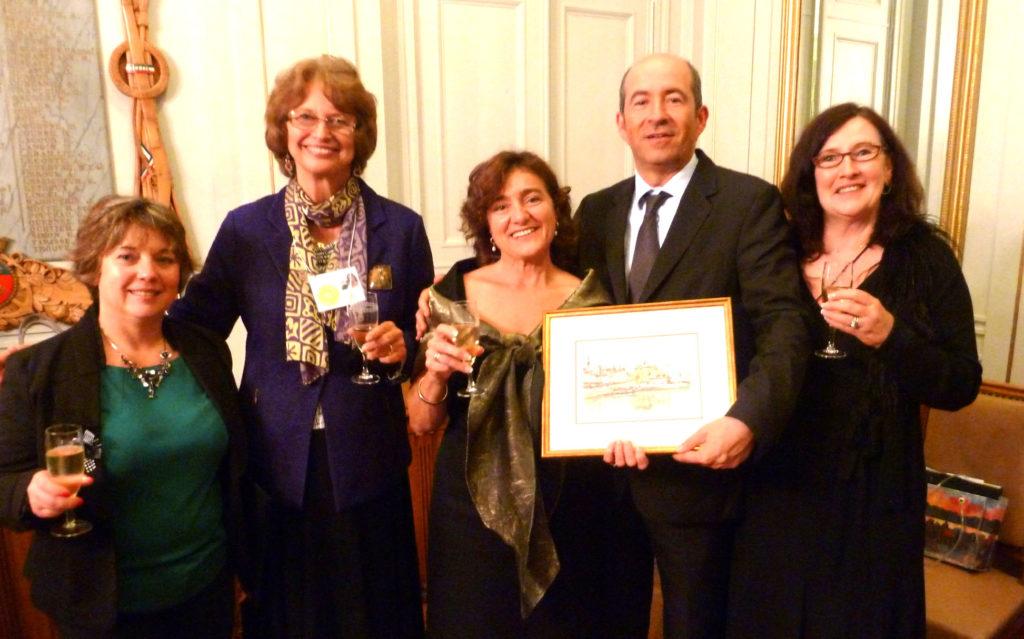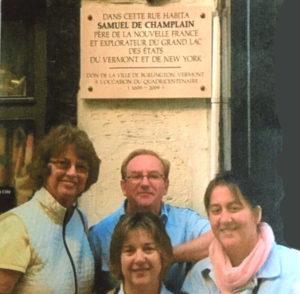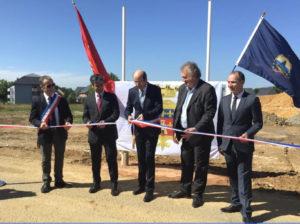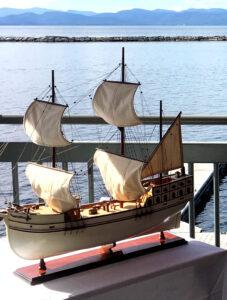In 1603 the French navigator and geographer Samuel de Champlain began exploring North America. He arrived in Quebec in 1608, founding the city of that name, and then a year later he undertook another voyage. This one took him along the St. Lawrence River to what is now Lake Champlain. He was the first European to set eyes on the lake, finding it so beautiful that he gave it his name.
Fast forward to the 2000s, when Burlington businessman Ernie Pomerleau, then serving as honorary consul of France in Vermont, read an article in The New York Times about Honfleur. He realized that due to their shared history, Honfleur would be a perfect Sister City for Burlington, perched on the eastern shore of Lake Champlain. “It was a no-brainer,” he told this writer. To pursue it, he met several times with Christophe Guilhou and Anne Miller from the French consulate in Boston.
But the wheels began turning in earnest when the City of Burlington set out to commemorate the four-hundredth anniversary of the illustrious explorer’s visit. In planning celebrations for what would be called the Champlain Quadricentennial (1609-2009), a handful of individuals played a leading role. To kick it all off, Doreen Kraft, executive director of Burlington City Arts, was eager to organize a voyage from Burlington to the places in France where Champlain had lived. To put it together she turned to Dana and Marc vanderHeyden at St. Michael’s College, who had experience in transatlantic organizing: for some years they had been leading an annual “French Heritage” trip to France for members of the St. Mike’s community to explore the French origins of the college.
Kraft asked the VanderHeydens to help organize a Champlain Quadricentennial voyage for May 2009. “We were interested,“ Dana vanderHeyden told me recently. So when she and Marc (a former St. Mike’s College president) traveled to France in the summer of 2008, they made sure to visit Brouage, the town near La Rochelle where Champlain was born; the harbor city of Honfleur, in Normandy, from which the explorer had set out on most of his voyages; and a certain arrondissement in Paris, where he had lived out his last years.
“We came back said to Doreen that we could work out a trip,” Dana recalled. When they proposed the voyage to the office of Mayor Bob Kiss, he was supportive, and Burlington City Arts would sponsor it. François Gauthier, France’s consul-general to New England, helped connect the organizers to relevant places. The eleven-day journey would be called “In Search of Samuel de Champlain’s France” and would depart on May 20, 2009.
While the vanderHeydens had been in Paris, they had visited the Rue Saintonge, in the Third Arrondissement, considered to be the area where Champlain lived late in his life. They looked for a historical marker of some kind but found none. “So many places in Paris have historical plaques,” Dana told me. “But nothing in the area commemorated his presence.”
They got an idea: as part of the Champlain Quadricentennial, the City of Burlington could donate a plaque, made of marble, to the arrondissement, to commemorate Champlain’s residence there. Back in Burlington, Dana wrote a letter to the arrondissement mayor, proposing that Burlington donate such a plaque. “We could bring it to you in Paris when we come over next year,” she explained.
The mayor’s assistant responded yes, they liked the idea. So Dana recruited a sculptor, who came from Proctor. As they developed the project, the sculptor proposed to use Vermont marble, which is green.
They wrote to the Third Arrondissement to let them know, but the assistant wrote back in a fury: “Pas accepté!” The plaque had to look like all the others in Paris—that is, it had to be made from comblanchien marble, which is white. The Proctor sculptor said he never heard of comblanchien. But in the end they managed to find suitable marble.
Meanwhile Vermont lieutenant governor Brian Dubie visited Honfleur, which was becoming ever more important for the Quad celebration as the starting point of the 1609 voyage. Honfleur officials would later refer to Dubie’s visit as the “germe de l’idée de rapprochement entre le Vermont et Honfleur, en particulier Burlington.”
As the Quad delegation’s departure date neared, Mayor Kiss let the members know that he was interested in exploring an official connection between Burlington and Honfleur, perhaps even a Sister City connection. Do what you need to do to make it happen, he told them.
The sculptor completed the commemorative plaque and carefully wrapped it for transport to France. It could not be shipped commercially; it was too fragile. About an inch thick, it could easily snap. The delegation would have to bring it with them on the plane. But it was too fragile to put with baggage. The group checked in for the flight and went through security. But where on the plane could it go? Doreen and Dana managed to speak directly to the pilot, explaining that it was a gift to city of Paris and too fragile to stow.
The pilot said, “Fine, put it in the cockpit with me.” Sure enough, while members of the group were boarding, someone from cockpit took the plaque from their hands and carefully placed it there. It crossed the Atlantic safely. “Then we had to take another flight to south of Brouage,” Dana recalled, wincing.
Led by Dana, the delegation visited the various Champlain sites, always handling the plaque with the utmost care. On May 26, they arrived in Honfleur, where the city government invited the group to attend a reception at the Hôtel de Ville. “It was quite a reception,” Dana recalled. “They were so excited to see us.” As it got under way, Doreen handed Mayor Michel Lamarre a letter from Mayor Kiss. The letter announced that at that very moment, thousands of miles away, Burlington in its City Hall was celebrating “Honfleur Day.”
“Mayor Lamarre was stupefied,” Dana recalled. “He said, ‘No place has ever proclaimed Honfleur Day! We need to stay connected.’” At the reception, she told me, “We all clicked.” The Vermonters frankly told Mayor Lamarre that Mayor Kiss was interested in a Sister City connection. The wheels were turning.
The next day, May 27, the Quad group moved on to Paris, where they stayed in a hotel in the Rue Saintonge. At the nearby Hôtel de Ville of the Third Arrondissement, Mayor Pierre Aidenbaum hosted a reception for them. There they presented him with the plaque, with these words etched into the stone:
Dans cette rue habita Samuel de Champlain, père de la nouvelle France et explorateur du grand lac des états du Vermont et de New York. Don de la ville de Burlington, Vermont à l’occasion du quadricentenaire (1609-2009)
The next step would be to install and dedicate the plaque, at a date to be determined.
Meanwhile, in the years following the 2009 Quadricentennial, the Burlington-Honfleur connection grew by leaps and bounds. Lise Veronneau became chair of a Sister City committee, and delegations from both sides alternated visits at more or less two-year intervals.
*On September 20, 2010, Mayor Kiss visited Honfleur personally, where he met with Mayor Lamarre. For the first time, they discussed a partenariat or partnership between the two cities.
*On March 21, 2012, Mayor Kiss created a Sister City committee, chaired by Lise Veronneau, to maintain communication with the Comité de Jumelage in Honfleur.
*On October 8, 2012, the first official delegation from Burlington visited Honfleur, where they signed a partnership agreement with their counterparts in the Hotel de Ville.
* In July 2013, a delegation from Honfleur visited Burlington. This time, on July 3, Mayor Lamarre and Burlington mayor Miro Weinberger signed a friendship agreement in City Hall, after which the Honfleur delegation toured sites in the Burlington area.
- In April 2014 a Boy Scout troop from Shelburne visited Honfleur.
But amid all the intensity around Honfleur, what became of the Parisian plaque? On September 7, 2013, the vanderHeydens traveled to Paris to find out. They met with several individuals from Honfleur, who were by now friends—city archivist Pierre Jan, Christine Mas, and several others—on a street in the Third Arrondissement. As they glanced over at the Hôtel de Ville, they happened to spot none other than Mayor Aidenbaum. They had no appointment, but they rushed over to him and asked about the plaque.
The mayor informed them that an official ceremony to inaugurate it would take place soon, on October 12. The vanderHeydens had a conflict and couldn’t attend—so Jan and Mas offered to represent Burlington on that occasion. That gesture did as much as anything to signal Honfleur’s friendly commitment to its Burlington connection. At the plaque’s official dedication on October 12, Pierre Jan did indeed make a speech on behalf of both Burlington and Honfleur.
The Burlington-Honfleur relationship drew ever closer. In December 2013 the two mayors agreed to the Free Admittance Agreement, allowing visitors from both cities to enter each other’s museums for free.
On June 18-28, 2015, Burlingtonians made another visit to Honfleur, in a group sponsored by Burlington City Arts. This “Tale of Two Arts Cities” trip, with nineteen travelers, would be a friendly visit to emphasize the arts. Just before their departure, the participants gathered at the statue of Champlain in Isle la Motte for a group photo. Once they were in Honfleur, accompanied by elected officials, they attended the inauguration of “Burlington Square” and “Quartier du Vermont” on the city’s outskirts. Paintings by the Vermont artist Sabra Field were exhibited at the Salle Carnot. And they visited the historic Ferme St. Siméon, once a residence of noted Impressionist painters including Claude Monet.
In October 2015, again in Paris, the vanderHeydens met with archivist and friend Pierre Jan. All agreed to press for an official Sister City connection between Honfleur and Burlington.
In the summer of 2017 Honfleur invited each of its several sister cities to send a pair of young people to collaborate on a video showing the city’s diversity. Burlington sent two youths who contributed to the video project.
A few months later, on October 7-14, 2017, a group of twelve from Honfleur made a friendly visit to Burlington. Led by Mayor Lamarre, it included members of the Comité de Jumelage. No document was signed—the group toured sites in the Burlington area, to the mutual enjoyment of French and Americans alike. Ernie Pomerleau, honorary consul of France in Vermont, organized the construction of a replica of Champlain’s ship, the Don de Dieu. He presented it to Mayor Lamarre and arranged for it to be shipped to Honfleur. Mayor Lamarre, in turn, presented the Burlingtonians with a painting.
Two years after that visit, the Sister City relationship finally became official. On November 5, 2019, the two cities simultaneously signed a Sister City Charter over a transatlantic video conference. At the Honfleur ceremony, Mayor Lamarre signed in the presence of Lise Veronneau. while in Burlington, Mayor Miro Weinberger signed at the same time.
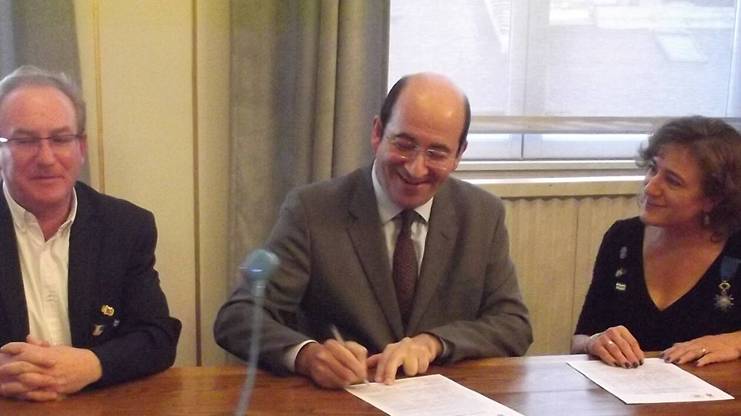
the charter in Honfleur

Mayor Weinberger signs it
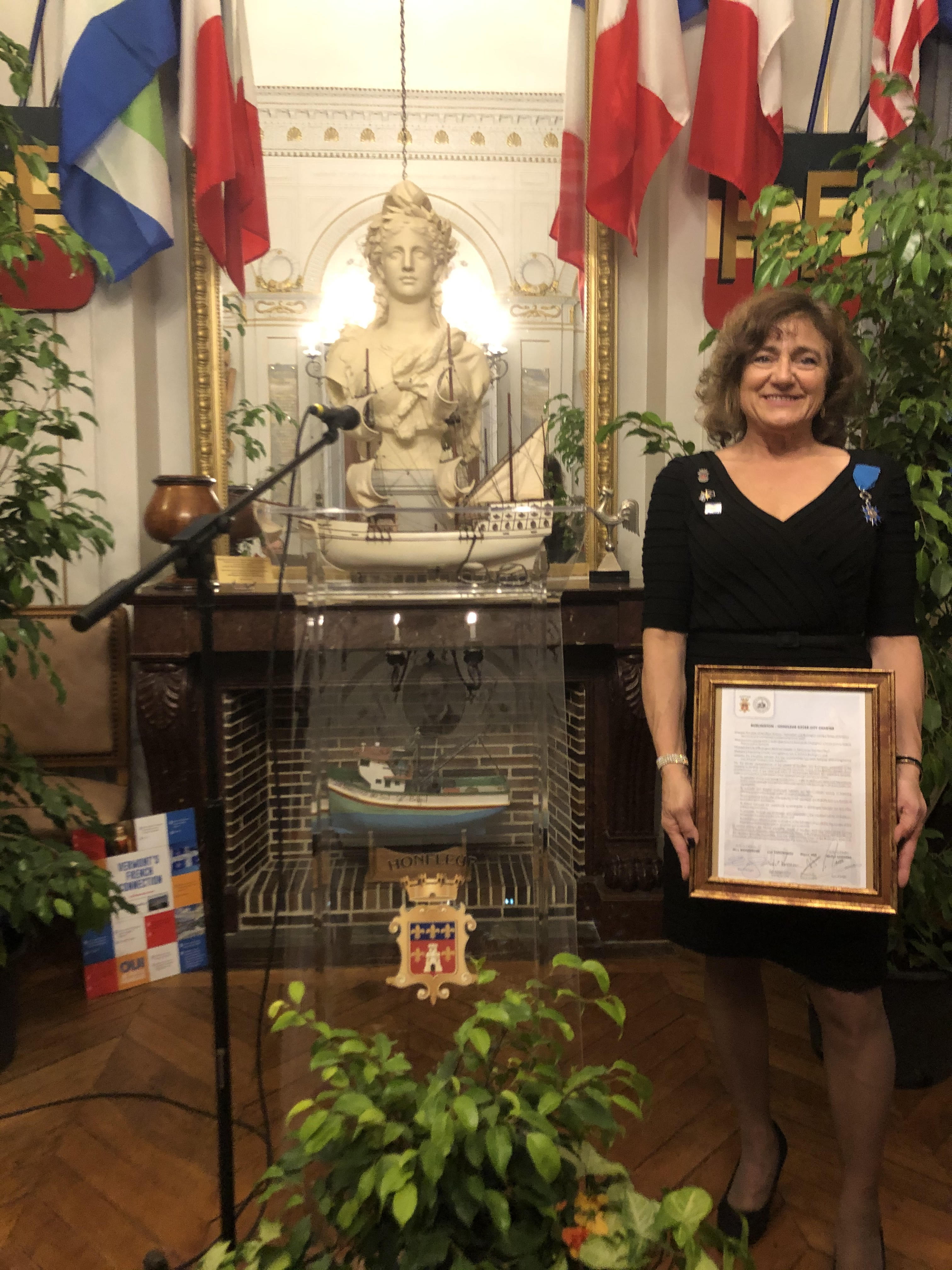
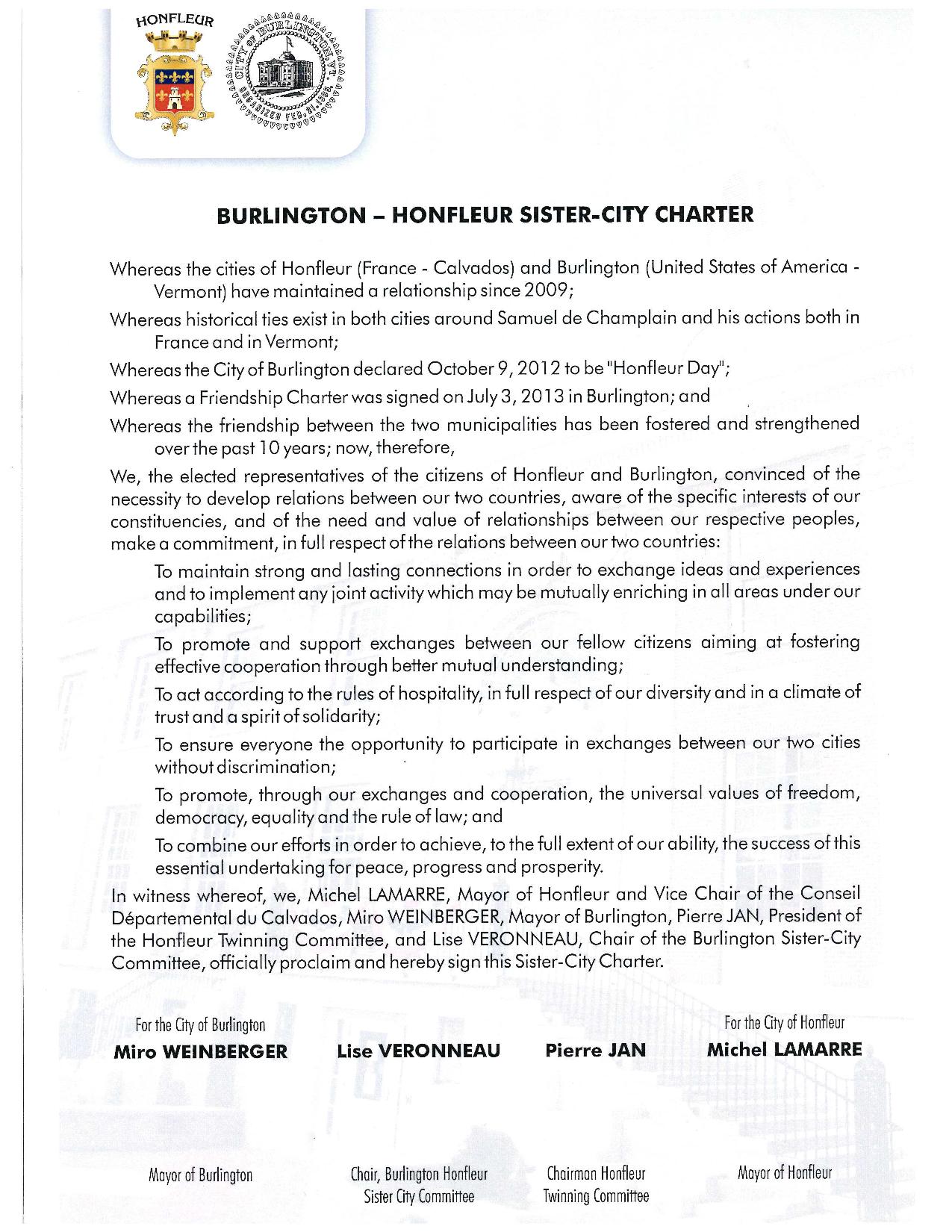
In both locations, local citizens attended the ceremony, and both mayors made speeches. Congratulatory remarks and toasts followed. In Honfleur, the hosts treated the Burlington visitors to a celebratory meal.
—Janet Biehl
Thanks to Dana vanderHeyden, ambassador from Honfleur to the United States, for sharing her memories, photos, and documents. Thanks to Lise Veronneau, chair of the Sister City Committee, for photos and comments. For more information, visit the Burlington-Honfleur Sister Cities website. This article has been updated since it was published, most recently on October 19, 2022.
